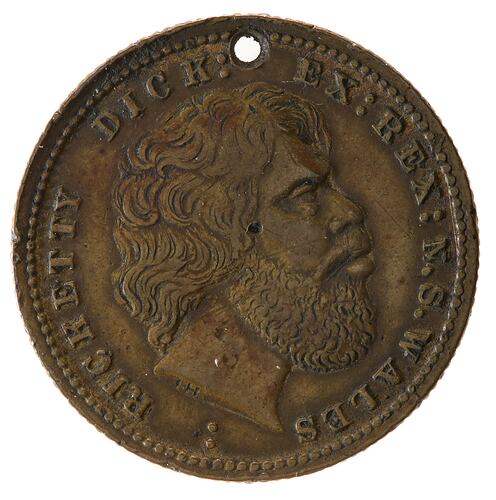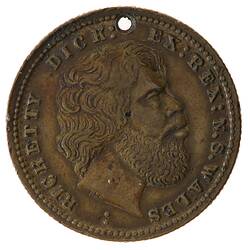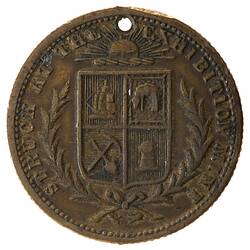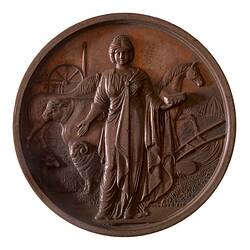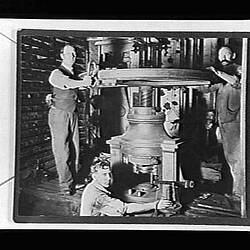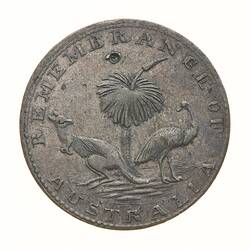Summary
Medals such as this were struck at a variety of Exhibitions around New South Wales, Queensland and Victoria in the final Quarter of the Nineteenth Century. The name of the person depicted changed but the portrait was that cut by Julius Hogarth for Stokes and Martin in 1872 (his initials IH appear on the truncation of the head in this case, suggesting an early date of production). The reverse shows an Australian shield below a rising sun. They were sold as mementos of the exhibition. This one is holed to facilitate wearing. The Aboriginal man whose head was depicted was known as 'Ricketty Dick'. He was familiar to people who travelled along the New South Head Road to Watson's Bay, in Sydney. Born around 1798, he camped on dry ground amongst the swamps of Rose Bay, near the site of the current Lyne Park.
Mint: Stokes.
Physical Description
A brass medal (22 mm diameter) holed to facilitate wearing and originally gilt (some gilding is retained in protected areas). It features Julius Hogarth's Aboriginal head facing right with the legend RICKETTY DICK EX REX N.S.WALES and on the reverse an Australian shield below a rising sun
Obverse Description
Bearded aboriginal man right; around, RICKETTY DICK: EX: REX: N.S.WALES : The artist's initials IH incuse on the truncation
Reverse Description
Quartered Arms within wreath; around, STRUCK AT THE EXHIBITION MINT
Edge Description
Milled
Significance
Ricketty Dick was portrayed in the earliest known Australian sculpture in silver, attributed to Julius Hogarth. It was displayed in the 1855 Paris Exposition Universelle. -Powerhouse Museum web site http://www.phm.gov.au. L.J. Carlisle. 1983. Australian Commemorative Medals and Medalets from 1799, p.13. -D. Tout-Smith 26/9/2003.
More Information
-
Collecting Areas
-
Date Issued
post 1872 AD
-
Issued By
-
Mint
-
Artist
Julius Hogarth, Melbourne, Greater Melbourne, Victoria, Australia, 1872
-
Person Depicted
-
Inscriptions
Milled (edge) RICKETTY DICK: EX: REX: N.S.WALES : Bearded aboriginal man right; around (obverse) STRUCK AT THE EXHIBITION MINT Quartered Arms within wreath; around, (reverse)
-
Series
-
Material
Bronze
-
Axis
12
-
Classification
-
Category
-
Discipline
-
Type of item
-
Dimensions
22 mm (Outside Diameter), 4.56 g (Weight)
-
Shape
Round with hole
-
References
Car.R5
[Article] Czernis-Ryl, Eva. 1996. Early Australian Silver Statuette: a Story of Julius Hogarth and Ricketty Dick.
-
Keywords
